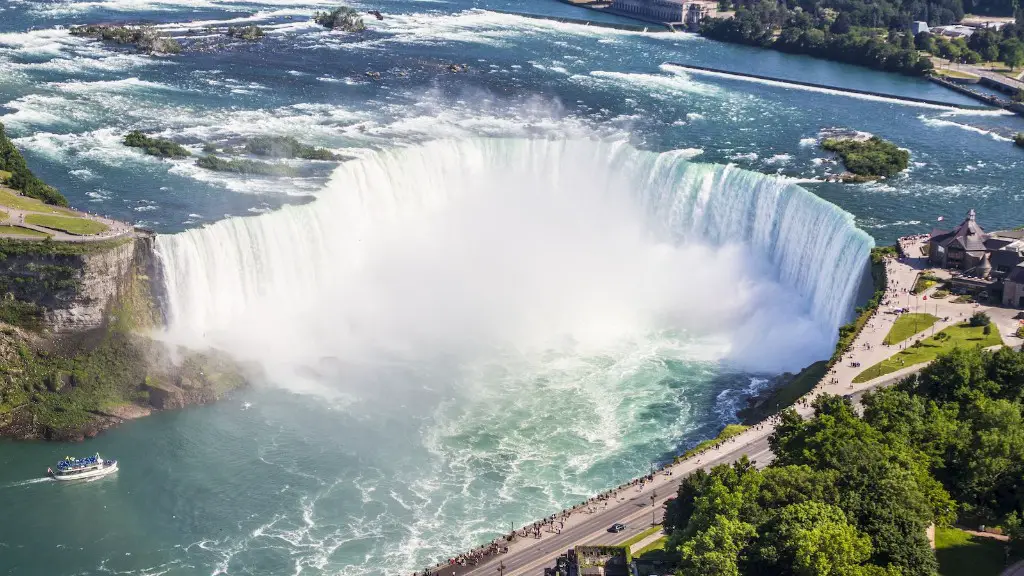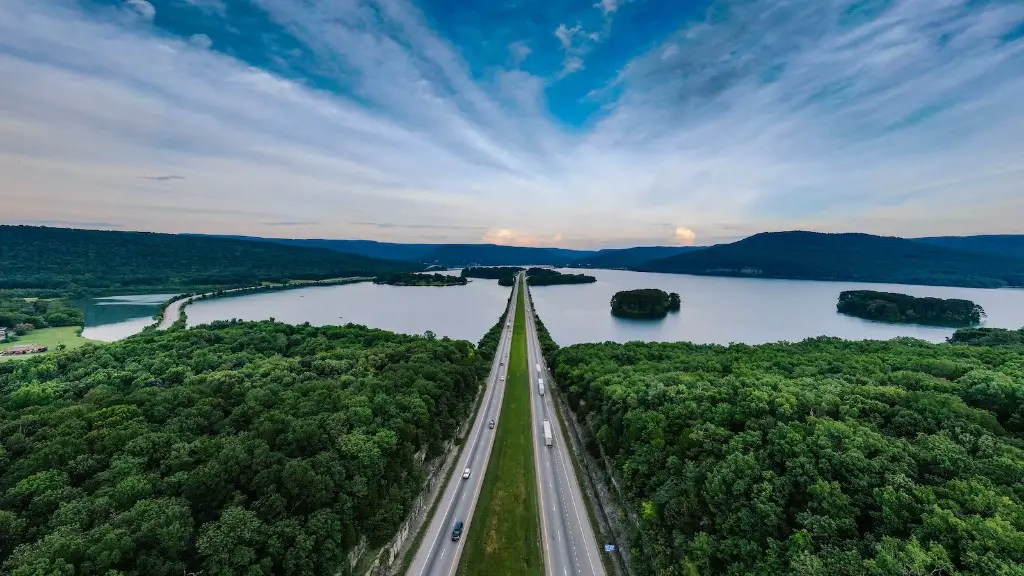The Mississippi River Basin is an expansive geographical area that is found mainly in the United States. It holds the title of being the fourth largest watershed in the world, and it has been an integral part of the history of North America. The river itself stretches for 2,340 miles, which is almost equal to the distance of Florida and California. Its basin spans 31 States and two Canadian provinces, tapping into 41 percent of the United States and an incredible drainage area of 1,245,000 square miles. On top of this, it supplies the main waterway for 31 of America’s largest cities.
At the headwaters of the Mississippi, there are several Lakes and rivers. These waterways, like the Missouri and the Upper Mississippi, all have their own drainage area and are part of the river basin’s vastness. In addition, a large portion of the basin is drained by tributaries like the Minnesota, Arkansas, Ohio and Illinois, providing important contributions to the overall size. Each of these tributaries has its own length, drainage area, and volume of water, which all contribute to the size of the Mississippi River Basin.
The sheer size of the Mississippi River Basin makes it a vital contributor to the economic security of millions of individuals and businesses in the states it serves. It is estimated that the river supplies over 50 percent of the nation’s agricultural outputs, and is essential to the power of the transportation and tourism industries, among others. In addition, it is home to several vital wildlife habitats, which include at least 10 federally recognized wildlife refuges.
The history of the Mississippi River Basin is one marked by struggles over water rights, environmental protection and land development. Its importance to the nation’s economy and ecology resulted in the formation of the Mississippi River Commission (MRC) in 1879, which is tasked with protecting the river’s navigability and overall health. Today, the MRC has broadened its scope to include water and air quality monitoring, wetland conservation, and science-based decision making techniques.
When discussing the size of the Mississippi River Basin, it is important to look at the impact that humans have had on it over the years. While the river is an incredibly resilient natural source, it can also be greatly affected by human activities, including pollution and sedimentation from agricultural runoff. In addition, the growing Southwestern states are experiencing an increase in demand for water and have increased their reliance on the basin for their needs. All this coupled with the MRC’s extensive efforts, makes it clear just how important it is to care for the health and well-being of the Mississippi River Basin.
Impact on Climate and Extreme Weather
The size of the Mississippi River Basin has an important role to play when it comes to climate and extreme weather events. This is because it is home to an extensive network of rivers and streams, which act as natural systems of control when there is an increase in rain or snow. The basin can regulate the flow of water, helping to reduce the potential damage that extreme weather can cause.
Further, the size of the basin has an effect on the climate itself. For example, the levees and dams help protect against flooding, which in turn reduces the amount of sediment deposited into the basin, leading to less soil disruption in the river beds. This can lead to a more stable climate overall, which can have a positive effect on the environment and weather patterns.
It is also important to note that the water from the Mississippi River Basin experiences significant heating in summer months, which can lead to lower water levels and weather extremes. Without the proper management of this basin, there is a potential that the water will become too hot and can no longer adequately support the biodiversity of the area.
Finally, the size of the Mississippi River Basin can also influence coastal erosion. As the shores of the Gulf of Mexico experience high winds and waves, the increased size of the basin can buffer the waves, helping to reduce the impact of the erosion. This can help protect infrastructure, human settlements, and other ecosystems in this region.
The size of the Mississippi River Basin has played an integral role in America’s culture and economy. As the country’s fourth largest river basin, it is an essential element in the navigation of goods and services. This is made possible through the series of reservoirs, dams and levees, which all allow vessels to transport commodities to different locations.
In addition, the size of the basin has enabled the river to become the main artery of commerce. This is because the large size of the Mississippi River allows commodities to easily make their way across the United States, while its unique geographical composition makes it an ideal system for connecting different industries.
The Mississippi River Basin also provides a plethora of recreational activities, from fishing to boating. This makes it a great location for individuals and businesses, who can benefit from the beauty of the region. Further, the large size of the basin leads to a diverse array of wildlife, making this an attractive destination for ecotourism.
Finally, the size of the Mississippi River Basin also provides an opportunity for research and study. Scientists have the opportunity to observe different species and study the effects that different practices have on the environment. By studying the basin, researchers are able to gain a better understanding of how humans and the environment interact.
Environmental Impact of Basin Changes
The size of the Mississippi River Basin has seen significant changes as a result of human activity. When looking at the environmental impact of these changes, it is important to consider how they affect the water quality, the food chain, and the overall ecosystem. As the basin has been subject to changes in land use, alterations in the hydrologic cycle and other modifications, there have been negative implications for the river.
For example, the increased size of the basin has led to an increased amount of water diversion and an increased amount of sediment deposited in the river resulting in a lower quality of water. This has resulted in a reduction in water availability for both agriculture and fisheries, and an increase in the amount of pollutants that enter the system.
Further, the changes in the size of the Mississippi River Basin have caused a disruption to the food chain. This is because the increased size has resulted in an alteration of the habitats available to the many species living in the basin. These changes have led to a decrease in biodiversity, which is detrimental to the entire ecosystem.
Finally, changes in the size of the Mississippi River Basin also have had a long-term impact on the environment. This includes changes to the wetlands, which provide essential habitat to species and help to reduce flood risk. In addition, the drying of wetlands can lead to a decrease in water quality, which affects not only the fish and plants that rely on these wetlands, but also the humans relying on its resources.
Conservation Efforts and Policy Reform
In order to protect the size of the Mississippi River Basin, it is important to implement conservation efforts and regulatory policy reforms. The Mississippi River Commission, as well as various organizations, have been working to strengthen the basin’s health by enhancing water quality and reintroducing wild habitats. These efforts are vital for preserving the size and health of the basin.
In addition, policy reforms have been put in place to ensure that the state governments work together to manage the resources in the basin. This includes forming legislation, such as the Water Resources Development Act of 1986, which helps to manage the water in the basin and ensure its availability for the use of citizens and the economy.
Further, it is important to consider the changes that have taken place on the agricultural side of the river, as agricultural runoff and chemicals have contributed to the decline of water quality in the basin. In order to protect the size and integrity of the basin, farmers should consider changing their farming practices and look into alternative agricultural methods that are less damaging to the environment.
Finally, it is important to look at the role that industry plays when it comes to the size of the Mississippi River Basin. Programs such as the EPA’s “Clean Water Initiative” are aiming to reduce the amount of pollutants entering the river, ensuring that the basis is kept healthy for future generations.
Sustainability of the Basin
With the increasing population and changing climate, it is crucial to consider the sustainability of the Mississippi River Basin. In order to ensure the health of the basin, it is important to consider ways to reduce consumption, implement conservation measures, and introduce regulatory policies.
One of the most impactful ways to ensure the sustainability of the basin is by reducing consumption. This can be done through better water management practices and by introducing water-use restrictions, which will help to ensure that the water is able to be used for the future. In addition, introducing a fee structure for water use can help to incentivize conservation.
Another key component of the sustainability of the Mississippi River Basin is the introduction of conservation measures. Programs such as the EPA’s “Clean Water Initiative” have already been implemented and continue to be expanded, helping to reduce pollution levels, protect water quality, and increase the availability of water for people and wildlife.
Finally, regulatory policy also plays an important role in the sustainability of the Mississippi River Basin. Through comprehensive policy reforms and revamped regulations, states can help to ensure that the river is maintained in a healthy state and that all stakeholders are in compliance with regulations. This will help to minimize negative environmental impacts of river management and promote long-term sustainability.





